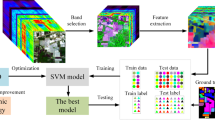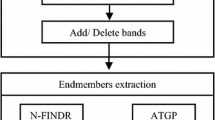Abstract
Dimensionality reduction (DR) is an effective preprocessing step in hyperspectral image (HSI) analysis. A particle swarm optimization (PSO)-based unsupervised DR method is proposed in the present paper where spectral divergence as well as spatial gradient information is used in selecting informative bands. In general, HSI is negatively affected by low signal-to-noise ratio (SNR). Hence, in the proposed method, a noise filter is applied to minimize the effect of noise in band selection. Clustering is introduced to reduce spatial redundancy and extract distinct patterns from the data. This enables improvement in the computation performance of each iteration in PSO. The proposed method is applied on two standard datasets, and the performance is evaluated using overall classification accuracy. Finally, results are compared with other recent state-of-the-art methods where the proposed method performed reasonably better than other tested methods in terms of consistency and classification accuracy.












Similar content being viewed by others
Explore related subjects
Discover the latest articles, news and stories from top researchers in related subjects.Data availability statement
Data sharing is not applicable to this article as no new data were created or analysed in this study.
References
Abidi MH, Alkhalefah H, Moiduddin K, Alazab M, Mohammed MK, Ameen W, Gadekallu TR (2021) Optimal 5G network slicing using machine learning and deep learning concepts. Comput Standards & Interfaces 76:103518. https://doi.org/10.1016/j.csi.2021.103518
Alipourfard T, Arefi H, Mahmoudi S A (2018) Novel deep learning framework by combination of subspace-based feature extraction and convolutional neural networks for hyperspectral images classification. IGARSS 2018 - 2018 IEEE International Geoscience and Remote Sensing Symposium, 2018, pp. 4780–4783, doi: https://doi.org/10.1109/IGARSS.2018.8518956
Banerjee BP, Raval S (2021) A particle swarm optimization based approach to pre-tune programmable hyperspectral sensors. Remote Sens 13(16):3295. https://doi.org/10.3390/rs13163295
Bevilacqua M, Berthoumieu Y (2017) Unsupervised hyperspectral band selection via multi-feature information-maximization clustering. In: Image Processing (ICIP), 2017 International Conference on (pp. 540–544). IEEE
Cao X, Han J, Yang S, Tao D, Jiao L (2016) Band Selection and Evaluation with Spatial Information. Int J Remote Sens 37(19):4501–4520. https://doi.org/10.1080/01431161.2016.1214301
Cao X, Wu B, Tao D, Jiao L (2016) Automatic band selection using spatial-structure information and classifier-based clustering. IEEE J Selected Topics in Appl Earth Observ Remote Sens 9(9):4352–4360
Cover TM, Thomas JA (1991) Elements of information theory. Wiley, Hoboken, NJ
Cook RD, Weisberg S (1982) Residuals and influence in Regression. Chapman and Hall, New York
Deepa P, Thilagavathi K (2015)Feature extraction of hyperspectral image using principal component analysis and folded-principal component analysis. In: Electronics and Communication Systems (ICECS), 2015 2nd International Conference on. IEEE, pp. 656–660.
Devijver PA, Kittler J (1982) Pattern recognition: a statistical approach, 1st edn. Prentice-Hall International, New Delhi
Gao H, Yang Y, Zhang X, Li C, Yang Q, Wang Y (2019) Dimension reduction for hyperspectral remote sensor data based on multi-objective particle swarm optimization algorithm and game theory. Sensors 19(6):1327
Gao H, Li C, Zhou H, Hong J, Chen L (2016) Band selection method of hyperspectral image for classification based on particle swarm optimization. J Comput Theor Nanosci 13(11):8823–8828. https://doi.org/10.1166/jctn.2016.6048
Ghamisi P, Benediktsson JA (2015) Feature selection based on hybridization of genetic algorithm and particle swarm optimization. Geosci Remote Sens Lett IEEE 12(2):309–313. https://doi.org/10.1109/LGRS.2014.2337320
Ghorbanian A, Mohammadzadeh A (2018) An unsupervised feature extraction method based on band correlation clustering for hyperspectral image classification using limited training samples. Remote Sens Lett 9(10):982–991. https://doi.org/10.1080/2150704X.2018.1500723
Gong M, Zhang M, Yuan Y (2016) Unsupervised band selection based on evolutionary multiobjective optimization for hyperspectral images. IEEE Trans Geosci Remote Sens 54(1):544–557
Gonzalez RC, Woods R (2007) Digital image processing, Pearson Prentice Hall, 2e.
Green AA, Berman M, Switzer P, Craig MD (1988) A transformation for ordering multispectral data in terms of image quality with implications for noise removal. IEEE Trans Geosci Remote Sens 26(1):65–74. https://doi.org/10.1109/36.3001
Hughes G (1968) On the mean accuracy of statistical pattern recognizers. IEEE Trans Inf Theory 14(1):55–63. https://doi.org/10.1109/TIT.1968.1054102
Kennedy J, Eberhart R (1995) Particle Swarm Optimization. Proceedings of IEEE International Conference on Neural Networks IV. pp. 1942 – 1948.
Kim B, Landgrebe DA (1991) Hierarchical classifier design in highdimensional numerous class cases. IEEE Trans Geosci Remote Sens 29(4):518–528
Kullback S (1959) Information theory and statistics. Wiley, New York
Kullback S, Leibler RA (1951) On information and sufficiency. Ann Math Stat 22(1):79–86
Li Q, Wang Qi, Li X (2019) An efficient clustering method for hyperspectral optimal band selection via shared nearest neighbor. Remote Sens 11(3):350. https://doi.org/10.3390/rs11030350
Li X, Du Z, Huang Y, Tan Z (2021) A deep translation (GAN) based change detection network for optical and SAR remote sensing images. ISPRS J Photogramm Remote Sens 179:14–34. https://doi.org/10.1016/j.isprsjprs.2021.07.007
Luo G, Chen G, Tian L, Qin K (2016) Minimum noise fraction versus principal component analysis as a preprocessing step for hyperspectral imagery denoising. Can J Remote Sens 42(2):106–116. https://doi.org/10.1080/07038992.2016.1160772
MacQueen JB (1967) Some methods for classification and analysis of multivariate observations, proceedings of 5-th Berkeley Symposium on Mathematical Statistics and Probability. Berkeley, University of California Press, 1:281–297
Paul A, Chaki N (2019) Dimensionality reduction of hyperspectral images using pooling. Pattern Recognit Image Anal 29(1):72–78. https://doi.org/10.1134/S1054661819010085
Paul A, Chaki N (2021a) Dimensionality reduction using band correlation and variance measure from discrete wavelet transformed hyperspectral imagery. Ann Data Sci 8:261–274. https://doi.org/10.1007/s40745-019-00210-x
Paul A, Chaki N (2020) Supervised data driven approach for hyperspectral band selection using quantization. Geocarto Int. https://doi.org/10.1080/10106049.2020.1822929
Paul A, Chaki N (2021) Dimensionality reduction of Hyperspectral image using signal entropy and spatial information in genetic algorithm with discrete wavelet transformation. Evol Intell 14:1793–1802
Paul A, Bhattacharya S, Dutta D, Sharma JR, Dadhwal VK (2015) Band selection in hyperspectral imagery using spatial cluster mean and genetic algorithms. Gisci Remote Sens 52(6):644–661. https://doi.org/10.1080/15481603.2015.1075180
Paul A, Sahoo P, Chaki N (2020b) Dimensionality reduction of hyperspectral images: a data-driven approach for band selection. In: Chaki R., Cortesi A., Saeed K., Chaki N. (eds) Advanced Computing and Systems for Security. Advances in Intelligent Systems and Computing, vol 1136: 11–27. Springer, Singapore
Paul A, Bhoumik S, Chaki N (2021) SSNET: An improved deep hybrid network for hyperspectral image classification. Neural Comput Appl 33:1575–1585
Paul A, Kundu A, Chaki N, Dutta D, Jha CS (2021) Wavelet enabled convolutional autoencoder based deep neural network for hyperspectral image denoising. Multimedia Tools Appl. https://doi.org/10.1007/s11042-021-11689-z
Paul A, Bhoumik S (2021) Classification of hyperspectral imagery using spectrally partitioned HyperUnet. Neural Comput Appl. https://doi.org/10.1007/s00521-021-06532-3
Reis MS, Dutra LV, Sant’AnnaEscada SJSMIS (2017) Examining multi-legend change detection in amazon with pixel and region based methods. Remote Sens. https://doi.org/10.3390/rs9010077
Sellami A, Farah M, Farah IR, Solaiman B (2018) Hyperspectral imagery semantic interpretation based on adaptive constrained band selection and knowledge extraction techniques. IEEE J Selected Topics in Appl Earth Observ Remote Sens 11(4):1337–1347
Shah-Hosseini R, Homayouni S, Safari A (2015) A hybrid kernel-based change detection method for remotely sensed data in a similarity space. Remote Sens 7(10):12829–12858. https://doi.org/10.3390/rs71012829
Su H, Cai Y, Du Q (2017) Firefly-algorithm-inspired framework with band selection and extreme learning machine for hyperspectral image classification. IEEE J Sel Topics Appl Earth Observ Remote Sens 10:309–320
Su H, Du Q, Chen G, Du P (2014) Optimized hyperspectral band selection using particle swarm optimization. IEEE J Selected Topics in Appl Earth Observ Remote Sens 7(6):2659–2670
Sun K, Geng X, Ji L (2015) Exemplar component analysis: A fast band selection method for hyperspectral imagery. IEEE Geosci Remote Sens Lett 12(5):998–1002
Sun Y, Wang S, Liu Q, Hang R, Liu G (2017) Hypergraph embedding for spatial-spectral joint feature extraction in hyperspectral images. Remote Sens 9(5):506. https://doi.org/10.3390/rs9050506
Valle YD, Venayagamoorthy GK, Mohagheghi S, Hernandez JC, Harley RG (2008) Particle swarm optimization: basic concepts, variants and applications in power system. IEEE Trans Evol Comput 12(2):171–195. https://doi.org/10.1109/TEVC.2007.896686
Wang Q, Lin J, Yuan Y (2016) Salient band selection for hyperspectral image classification via manifold ranking. IEEE Trans Neural Netw Learn Syst 27(6):1279–1289
Xie C, Zou X, Xia X, Wang Z (2015) A multi-objective particle swarm optimization algorithm integrating multiply strategies. Acta Electron Sin 43:1538–1544
Xu M, Shi J, Chen W, Shen J, Gao H, Zhao J (2018) A Band selection method for hyperspectral image based on particle swarm optimization algorithm with dynamic sub-swarms. J Signal Process Syst 90(8–9):1269–1279.
Yuan Y, Zheng X, Lu X (2017) Discovering diverse subset for unsupervised hyperspectral band selection. IEEE Trans Image Process 26(1):51–64
Zhang M, Ma J, Gong M (2017) Unsupervised hyperspectral band selection by fuzzy clustering with particle swarm optimization. IEEE Geosci Remote Sens Lett 14(5):773–777
Zhang W, Li X, Zhao L (2018) A fast hyperspectral feature selection method based on band correlation analysis. IEEE Geosci Remote Sens Lett 15(11):1750–1754
Funding
The authors have not disclosed any funding.
Author information
Authors and Affiliations
Corresponding author
Ethics declarations
Conflict of interest
On behalf of all authors, the corresponding author states that there is no conflict of interest.
Additional information
Publisher's Note
Springer Nature remains neutral with regard to jurisdictional claims in published maps and institutional affiliations.
Rights and permissions
About this article
Cite this article
Paul, A., Chaki, N. Band selection using spectral and spatial information in particle swarm optimization for hyperspectral image classification. Soft Comput 26, 2819–2834 (2022). https://doi.org/10.1007/s00500-022-06821-6
Accepted:
Published:
Issue Date:
DOI: https://doi.org/10.1007/s00500-022-06821-6




